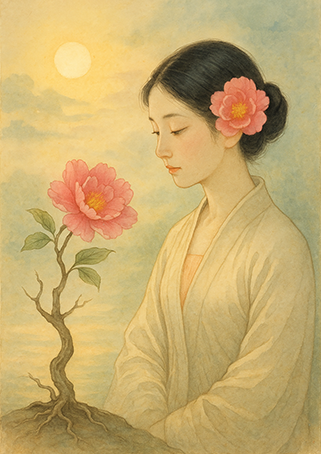Xieyi・The Rootless Tree:100 Verses-Verse 8#316

The poems of “The Rootless Tree” express a fundamental force rooted in harmony with heaven and earth, the cyclical flow of yin and yang, and the infinite potential of existence。
This painting is an expressive “Xieyi” in the tradition of “futu” (spiritual diagrams), passed down for generations in Wudang Mountain, China. It is drawn through a technique where energy flow (xingqi) channels the internal intention into visual form。 In the Taoist world, there exist spiritual and symbolic images called “futu”。
In the Taoist world, there exist spiritual and symbolic images called “futu”。
These are a type of talisman—not merely religious items, but expressive spiritual paintings that act directly on the mind of the viewer。
Since ancient times, many people have placed these Taoist-style “Xieyi” and futu in their homes, studies, or bedrooms, wishing for longevity, health, auspiciousness, and family harmony. Viewing such paintings was not just aesthetic appreciation, but an act of inviting the presence of the Dao into one’s life and tuning the body and mind。
Thus, “Xieyi” is more than artistic expression—it is a medium that bridges the spirit, life, and harmony with the universe。
This kind of artwork is not meant to be seen only with the eyes, but felt with the heart。
It communicates with the Dao, resonates with the qi of nature, and quietly stirs the viewer’s inner self。
Futu and “Xieyi” continue to live on from ancient times to this day as “sacred images that speak to the soul.”
Below, we present the original text of the philosophical poem “The Rootless Tree,” along with a modern Japanese translation and interpretation。
※ The author of “The Rootless Tree,” Zhang Sanfeng (1247–?), is also renowned as the founder of Tai Chi, and it is said that he applied the essence of this work to Tai Chi. As an additional note, we include an interpretation connecting this to the Tai Chi tradition of Wudang Mountain.
The Rootless Tree・Verse 8

▶Original Text
無根樹,花正新,産在坤方坤是人。摘花戴,採花心,花蕊層層艷麗春。
▶Modern Translation
A new flower blooms on a rootless tree,
Born in the direction of Kun, the earth trigram that stands for humanity.
Pluck the flower, wear it in your hair, and take its heart.
Its layered petals shine with spring’s brilliance.
▶Interpretation
1.[無根樹,花正新] – New radiance appears amid freedom.
2.[產在坤方坤是人] – Kun (earth) signifies receptivity and the human realm; true beauty begins in gentle acceptance.
3.[摘花戴,採花心] – Adorn yourself with the blossom but seek the flower’s heart—its essence.
4.[花蕊層層艷麗春] – Depth upon depth of petals create spring’s splendour; inner essence gives outer beauty meaning.
▶Interpretation related to Tai Chi
External form may look fine, yet only when practice touches the “flower’s heart” (dantian, intention, qi) does real gongfu bloom in layered richness.
Copyright © MASAKI WAKABAYASHI. All rights reserved.




